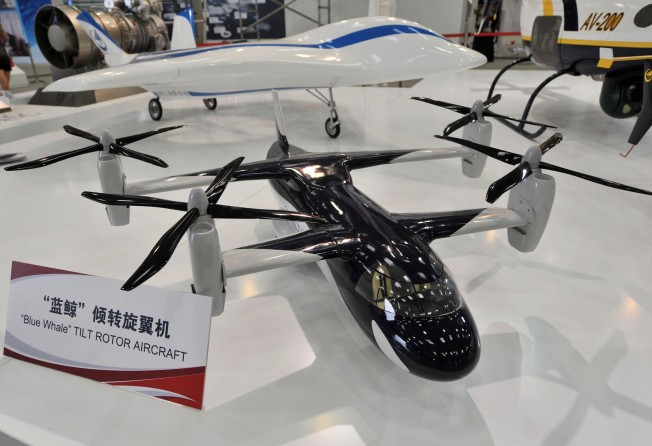
Engineers pursue the ‘Blue Whale’ - the helicopter that can exceed 700km/h
Blue Whale among the most innovative - and risky - designs on drawing board as Chinese engineers try to build world's fastest helicopter

In the past decade, China has commissioned its first aircraft carrier, put its first astronauts into orbit and built a high-speed rail system that is the envy of many developed countries.

Among the most ambitious of such aircraft in the works is the four-rotor "Blue Whale", a project by the China Helicopter Research and Development Institute. By tilting its four rotors from a horizontal to vertical position, the helicopter promises to reach speeds of more than 700km/h - which would make it the fastest "tiltrotor" in the world, 40 per cent faster than Boeing's V-22 Osprey, according to the institute.
With a cruising speed of 538km/h, developers say the Blue Whale will lift 20 tonnes of cargo and fly more than 3,100 kilometres without refuelling. It will fly as high as 8,600 metres, also higher than the V-22.
Qiu Guangrong , a director of the institute, told the Global Times last year the group hoped to produce functioning prototypes of its high-speed helicopter within the next five years, although he did not specify which models would be the first produced.
Even today, most conventional helicopters are not suited for speeds exceeding 200 km/h. Above certain speeds, airflow between blades can throw the aircraft off balance. Huge stresses are also placed on engines and mechanical parts, which can fail or break apart.
Over the decades, helicopter designers have tried numerous solutions to break the speed barrier. The twin rotors on Boeing's CH-47 Chinook, for instance, spin in opposite directions to cancel out each other's turbulence. The experimental Eurocopter X3, which has a conventional rotor plus twin propelling rotors on fixed wings, reached 486km/h in June.
Tiltrotors like the Blue Whale have rotor pods - called nacelles - mounted on fixed wings. The rotors provide lift in the horizontal position and forward thrust in the vertical position once the craft is airborne.
The government has provided a huge amount of support for the country's high-speed helicopter projects, which is closely tied to the People's LiberationArmy's efforts to build a more modern, mobile military.
In a visit to the institute this month, Lin Zuoming , head of Aviation Industry Corporation of China, the institute's parent body and the nation's biggest state-owned aerospace manufacturer, told researchers that "all eyes are on the helicopter industry" which offers "unprecedented opportunities".
"Enemies are at the gate," he was quoted on the institute's website as saying. "Factories and research institutes must … rely on the government's support to catch up and overtake the world's best."
But some doubt whether the institute will be able to produce a functioning prototype of the Blue Whale within its five-year window. The four-rotor design creates its own unique problems, chief among them how to compensate for the turbulence placed on the rear rotors by the front rotors during flight.
"When the Blue Whale is rolled out depends on when these problems are solved," said Professor Chen Ming , an expert on helicopter design at Beihang University in Beijing. "To me the future is very uncertain." Chen and several other mainland helicopter experts declined to comment on the project as it involved classified military technology.
Some in the industry also doubt whether China even needs to develop high-speed helicopters while it is still struggling to catch up with developed nations in conventional helicopters.
The weakness of domestic helicopters was exposed during rescue efforts after the Sichuan earthquake in 2008. The PLA sent its most advanced helicopters to the area, but television footage showed that the bulk of the rescue work was carried out by Black Hawk helicopters imported from the US in the 1980s.
Less advanced domestic helicopters proved incapable of operating at high altitude.
The Blue Whale could play vital role in such situations, although the institute said it is being developed mainly for military applications so 'the Chinese army and navy can achieve 'all-terrain reach'."